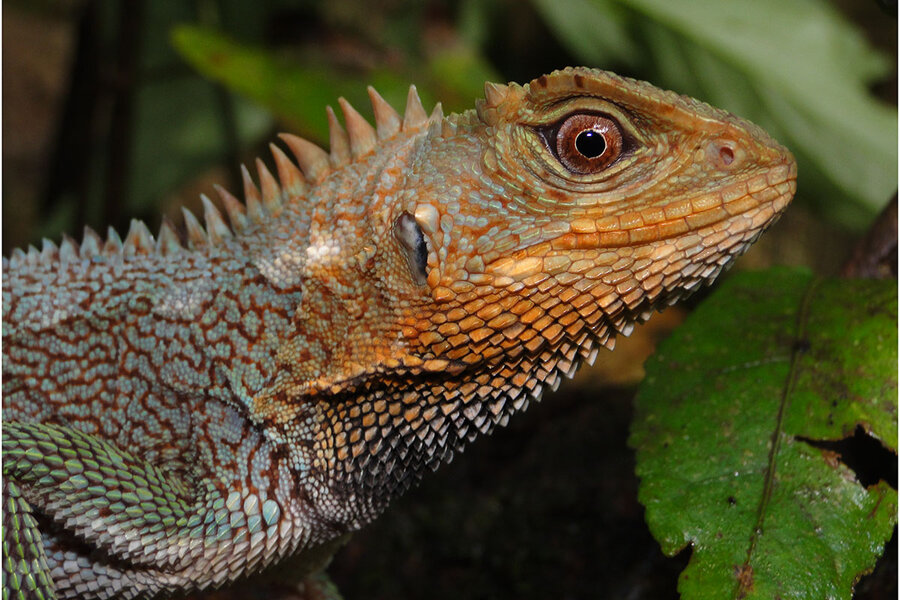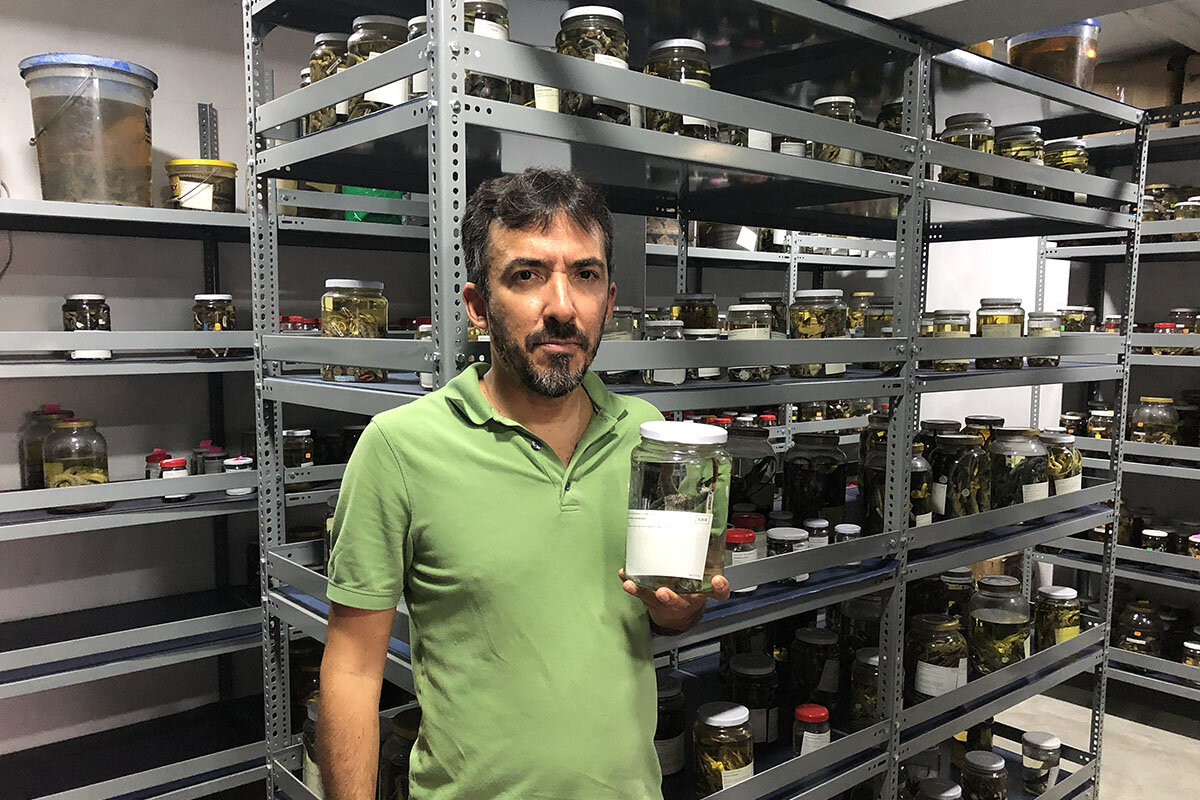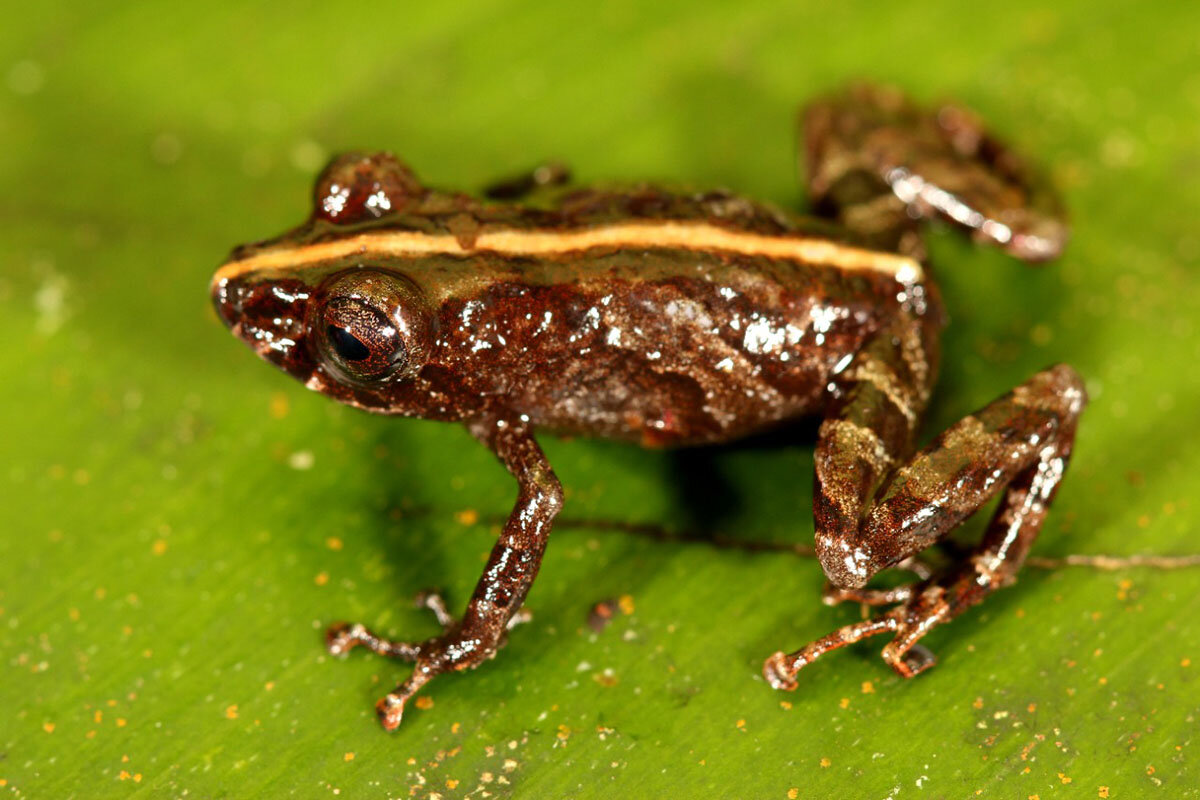Not just another lizard: Peruvian beauty offers extinction counternarrative
Loading...
| Lima, Peru
After a couple of decades poking around Peru’s remote rainforests – some large swaths still untouched by invading woodcutters, miners, cattle grazers, and coca farmers – Pablo Venegas has developed an eye for what is different and even unknown to humankind.
In that time the herpetologist has the discovery of several dozen new frog, snake, and lizard species to his credit.
So when a gorgeous wood lizard with gold-rimmed eyes and a delicate mosaic hide of iridescent blues, oranges, and greens scooted by him several years ago, Mr. Venegas had a hunch the showy reptile was going to add to his list.
Why We Wrote This
Pollution. Climate change. Extinctions. The news about biodiversity is justifiably grim. But in Peru's rainforests, new species are still revealing themselves, a reminder of richness worth preserving.
And he was right. A lengthy scientific process, these days including DNA sequencing, revealed that what Mr. Venegas had discovered in Peru’s Huallaga River basin was a “new” species of lizard, in that it was previously unknown to humanity.
The announced discovery of a new lizard in a distant rainforest may elicit a blasé “so what?” from some. But amid a crescendo of extinctions and warnings about threatened flora and fauna around the globe, Enyalioides feiruzae, as Mr. Venegas named the lizard, offers a hopeful counternote about the state of Earth’s biodiversity.
Indeed, when Mr. Venegas was able to officially announce his discovery this fall, the glimmer of good news was lost amid reports of extinctions and species decline.
In the United States, federal wildlife officials announced in October that 23 species are gone forever and should be declared extinct. They included several Hawaiian songbirds and the much-mourned ivory-billed woodpecker – a species once common to Southern U.S. woodlands and so imposing it earned the moniker “Lord God bird.”
In Europe, BirdLife International announced in October an updated “red list” that found as many as one-fifth of Europe’s bird species are declining rapidly toward extinction.
Overall, scientists have declared that Earth is in its sixth mass-extinction era – but this one the first to be the result not of volcanoes or asteroids but of human activity that has polluted the environment, warmed the climate, and destroyed habitats.
Against that backdrop, Mr. Venegas says the discovery of new species should not in any way be used to soften the alarm over the global loss of biodiversity. But it should, he adds, provide encouraging evidence that there is still time to preserve much of Earth’s biological richness – some of which is still unknown to humans.
“I think there is an element of optimism in being able to announce a species of frog or reptile that previously wasn’t known, but it’s not about crying victory,” says Mr. Venegas, standing in the specimen storeroom of the Center for Ornithology and Biodiversity (CORBIDI) in Lima, where he has been curator of amphibians and reptiles since 2007.
“We have people tell us, ‘All we hear about today is how species are disappearing, but you’re finding new species, so it seems we’re doing OK.’ But that’s not the message people should take from this,” he adds. “Much better if the hopefulness of a new species discovery energizes efforts to preserve nature and find out more about what’s out there.”
Beyond the exhilaration that goes with announcing a piece of nature no one knew existed, there are also practical motivations behind the work of discovering new plant and animal species. CORBIDI is a small scientific nongovernmental organization that survives on foreign donors, the most important of which is the Rainforest Partnership, based in Austin, Texas.
Those donors value evidence that their dollars are getting results.
At a national level, finding new species and compiling the rich natural inventory of little-studied areas helps activists and organizations like CORBIDI pressure the government to create new nature reserves – or do a better job of protecting existing ones.
And even though Peru is already recognized internationally as a biodiversity hot spot, the discovery of new species creates the kind of fanfare that helps Peruvian environmental officials attract more international support and funding for the country’s rich but often poorly protected nature reserves.
Enter the new earless frog with a distinctive cross marking between the eyes and along the back, announced in April by Peru’s service for natural protected areas, SERNANP.
“One new frog species may seem like a small thing, but when it’s part of a growing list of new species discoveries, that frog helps us secure Peru’s place as a highly biodiverse country worthy of international support for investigating and protecting what we have,” says Edgar Vicuna, communications director of SERNANP in Lima.
Over the past five years, SERNANP has announced 67 new species – over half of which were plants, including a number of orchids. But the list also includes 17 amphibians and four new bird species.
And while adding new species helps Peru secure its reputation for “mega” biodiversity, it can also give the country a boost on international “most species” lists – a point of pride for SERNANP and many Peruvians, especially those involved in scientific investigations or activities like ecotourism.
Noting that Peru is No. 1 globally in butterfly species, ranks third in birds, fourth in amphibians, and seventh in reptiles, Mr. Vicuna says discovering new species can “help us go up in those rankings and add to our international renown for biodiversity.”
Of course with that fame comes a responsibility to protect those natural riches. Mr. Vicuna says Peru is working hard at preservation, redoubling efforts at establishing agreements with communities in biodiverse areas to promote economic activities that help preserve sensitive areas instead of destroying them.
But he underscores that nearly 20% of Peru’s territory has been declared nature reserves, with the country’s national parks the “jewels” of that vast terrain with some level of protected status.
Mr. Venegas of CORBIDI says his experience in the field tells him many of Peru’s biodiversity hot spots aren’t adequately protected. Park rangers are often woefully outnumbered by illegal miners on the hunt for gold, woodcutters snatching prized tropical woods, farmers clearing land for grazing cattle – and armed drug traffickers.
Indeed, a number of the herpetologist’s species discoveries occurred when he was alerted to a new road being built into an uninvestigated area, or to human activity pressing into a protected zone – prompting him to rush in to do species inventories.
“It’s important that we go into threatened areas and get a full accounting of what exists there – for one thing, so that we know what risks being lost,” he says.
As he pursues his search for new species, Mr. Venegas says he remains encouraged by a fact that might surprise many people accustomed to hearing dire reports of biodiversity loss and species extinction.
“The reality is that the rate of discovery of new species continues to surpass the rate of confirmed extinctions,” he says. “We don’t know how long that will be the case, especially given the accelerating pressures on areas of high biodiversity.”
Noting that even as a little boy he was fascinated by reports of a new bird or perhaps a previously unknown rodent found somewhere in the world, he adds, “To me it’s reassuring that there are still places of great natural wealth to be explored and unknown species to be discovered.”









